Growing medicinal plants indoors vastly increases your ability to cultivate a comprehensive survival apothecary. Starting healing herb and plant seeds indoors is always a great idea, but there is so very much more you can cultivate than the typical native species of medicinal crops.
By growing indoors you can incorporate non-native and dwarf varieties of medicinal herbs, plants, and root into your apothecary plans. Two of the most powerful healing plants on Earth can only be grown in only a handful of ultra hot locations in the United States. But, purchasing root or dwarf versions of these plants you can grow them entirely indoors or rotate them outdoors just during the summer months.
Because the first two medicinal plants on the list are rarely ever grown in the United States (at least not in a residential setting) I will go into greater detail regarding their cultivation.
Tarragon
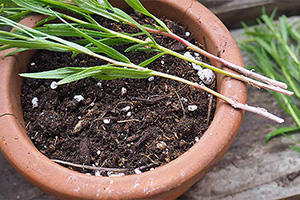 This healing herb can help treat stomach aches, toothaches, and insomnia. Tarragon could also help improve insulin sensitivity and help regulate blood sugar. It can also help normalize sleep patterns and reduce pain associated with Osteoarthritis, as well as sparking an increase in appetite.
This healing herb can help treat stomach aches, toothaches, and insomnia. Tarragon could also help improve insulin sensitivity and help regulate blood sugar. It can also help normalize sleep patterns and reduce pain associated with Osteoarthritis, as well as sparking an increase in appetite.
Tarragon Growing Tips
#1. Seeds should be sown about four to six to a medium container.
#2. Plant the seeds in a lightweight and moist potting soil.
#3. Tarragon seeds should be covered lightly with a paper towel or cotton cloth to facilitate low light conditions until they have sprouted.
#4. Once the seeds have grown at least two inches tall, they can be thinned out and each transplanted to their own pot.
Related: The Best Natural Sleeping Pill That You Can Grow In Your Backyard
Dwarf Moringa Tree
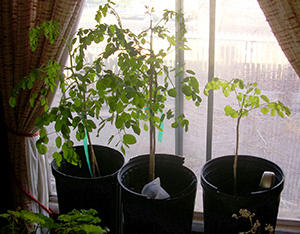 Not only can you eat nearly every part of the Moringa Tree, is it also packed with so many healing properties that is has long been nicknamed, “The Tree of Life.” Moringa trees are also highly regarded for how rapidly they grow. Unfortunately for preppers who do not live in southern regions of Florida, Texas, California and in Arizona, growing these trees has long been thought impossible.
Not only can you eat nearly every part of the Moringa Tree, is it also packed with so many healing properties that is has long been nicknamed, “The Tree of Life.” Moringa trees are also highly regarded for how rapidly they grow. Unfortunately for preppers who do not live in southern regions of Florida, Texas, California and in Arizona, growing these trees has long been thought impossible.
Growing dwarf moringa trees indoors is entirely feasible no matter what climate you happen to be located. It cost me a whopping $3.50 to purchase a packet of 10 dwarf moringa tree seeds – and they all sprouted within a single week.
- Moringa trees are rich in vitamins A, B, C, E, and K, protein,essential amino acids, beta-carotene, and manganese.
- Both the gum and the bark from the tree can be eaten for to garner their medicinal properties and nutrients.
- The leaves from the tree can be eaten raw, dehydrated, or infused into a tea.
- The pods can be cracked out and the inside consumed or eaten much like okra.
- Flowers from the moringa tree can be eaten raw but are far more tasty when fried or broiled.
- The seeds growing inside the drumstick portion of moringa trees contain ben oil. Not only is the oil a powerful component in natural remedies, it can also be used as a mechanical and firearms lubricant. The oil can also be used to filter water to make it potable.
It will take two years for the moringa tree seeds you plant in a container that is 16 inches in diameter, to sprout. You can plant about eight seeds in a single container and then thin them out as needed. You can pinch off the leaves of the growing dwarf tree to use for medicinal purposes as it grows into its mature state.
Moringa trees do not grow well in soggy soil and will need to be placed in both a soil and a container that facilitates quality drainage. If the leaves on the tree begin to turn yellow, add some magnesium to the dirt – egg shells, Epsom salts, or oyster shells are highly recommended.
Related: How To Make Moringa Powder (DIY – With Pictures)
Turmeric
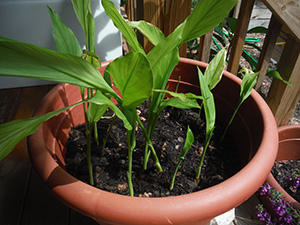 If you could only grow one medicinal plant indoors, it should be turmeric. This bright orange spice is the only source of the powerful antioxidant, curcumin. This turmeric component is garnered from the dried rhizome or root cuttings, of the turmeric plant.
If you could only grow one medicinal plant indoors, it should be turmeric. This bright orange spice is the only source of the powerful antioxidant, curcumin. This turmeric component is garnered from the dried rhizome or root cuttings, of the turmeric plant.
Curcumin has been used by herbalists for thousands of years to and it has been found to reduce joint and muscle inflammation and arthritis stiffness. It may also be beneficial for enhancing brain health and function and in fighting certain cancers, depression, and Alzheimer’s.
A United States National Library of Medicine and National Institutes of Health study maintains curcumin might also improve endothelium (blood vessel lining) function – helping to prevent heart disease.
Turmeric Growing Tips
#1. Purchase root cuttings at a local supplier or online. One turmeric root should be enough to grow multiple new cuttings.
#2. Break up the rhizome into small portions. Each one of the pieces must have at least one bud on it for it to grow.
#3. In a large growing container (5-gallon bucket recommended) place on of the rhizome pieces. The larger the pot, the bigger and stronger the turmeric start will grow. The growing container must have drainage holes drilled into the bottom to prevent the root stock from becoming over saturated. Plant the starts in potting soil that has been slightly moistened.
#4. The turmeric rhizomes should be planted two inches deep. The buds on the root stock must be facing upward.
#5. Turmeric quickly thrives in full sun conditions, but will still flourish beneath grow lights. It is highly recommended to move the growing container outside during the late spring and summer months – but only after the threat of any lingering frost has passed.
#6. Turmeric should be watered approximately every two days to ensure it remains moist beneath the hot summer sun or artificial grow lights. Misting the turmeric lightly in between waterings may also be necessary to prevent the soil from drying out. Be mindful not to make the soil soggy or it will likely cause the turmeric to rot.
#7. It typically takes between eight to 10 months for the turmeric to mature. Harvest each root as one whole piece. Remember to save some pieces of the rhizome for starting more turmeric. Never replant in the same soil the turmeric was just harvested from, it will be too depleted of nutrients.
To process the harvested turmeric, boil the rhizomes for around 45 minutes. Place them on a drying rack in a spot that is no hotter than room temperature (cooler is better, but the spot cannot be damp) for seven days. Peel the dried rhizomes and powder the insides. Wear gloves, turmeric will stain anything it touches orange.
Related: How to Make All-Natural Homemade Turmeric Pain Pills
Garlic
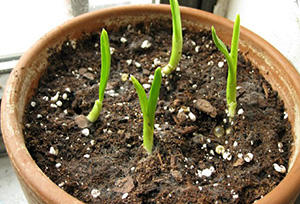 Garlic is a natural wonder “drug.” This hardy and easy yet time consuming to grow medicinal plant is a base ingredient in 98 percent of the natural remedies I make.
Garlic is a natural wonder “drug.” This hardy and easy yet time consuming to grow medicinal plant is a base ingredient in 98 percent of the natural remedies I make.
Garlic Top Medicinal Uses
- Draws toxins and impurities out of the body
- Treats and prevents gum disease
- Helps treat common cold and flu symptoms, especially a persistent cough
- Treats yeasts infections
- Garlic oil helps remove splinters
- Heals cold sore
- Soothes yeast infection discomfort and helps correct the problem
Garlic Growing Tips
#1. Cloves can be planted in the same container but must be spaced 1 to 2 inches apart.
#2. The root side of the clove – the narrow pointy part, must be placed down into the dirt first.
#3. Plant the cloves between four to six inches deep in a compost rich potting soil.
Related: How To Prepare Medicinal Pickled Garlic
Ginger
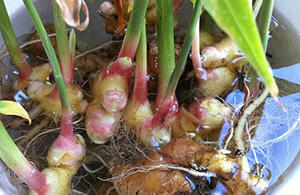 This medicinal root is highly regarded for its antioxidant, antibacterial, antiviral, and anti-nausea properties. Ginger’s anti-inflammatory properties make it a valuable natural remedy ingredient when combating headaches, migraines, joint pain, and menstrual problems.
This medicinal root is highly regarded for its antioxidant, antibacterial, antiviral, and anti-nausea properties. Ginger’s anti-inflammatory properties make it a valuable natural remedy ingredient when combating headaches, migraines, joint pain, and menstrual problems.
Ginger Growing Tips
#1. Purchase ginger root from a garden supply store or get a root cutting from a friend. The root should boast a firm skin, be plump, firm, and have multiple eyes on it – similar to the type of buds that grow on potatoes.
#2. Cut the ginger root into sections that each contain one bud.
#3. Soak the ginger root pieces in warm water for eight to 12 hours. Drain the water and shake the root sections to a semi-dry state before planting.
#4. Ginger root grows horizontally and will need a wide plant and well-draining compost rich potting soil to thrive.
#5. Plant the root with the eye pointing toward the soil surface.
#6. Plant the root sections one to inches deep and immediately water lightly.
#7. Ginger should not get a lot of sunlight and the container needs to stay warm throughout the growing period.
#8. The soil needs to remain moist but fight the urge to over water.
#9. Ginger sprouts should become visible in 14 to 21 days. It takes several months of growth before portions of the ginger root can be cut away and harvested.
Peppermint
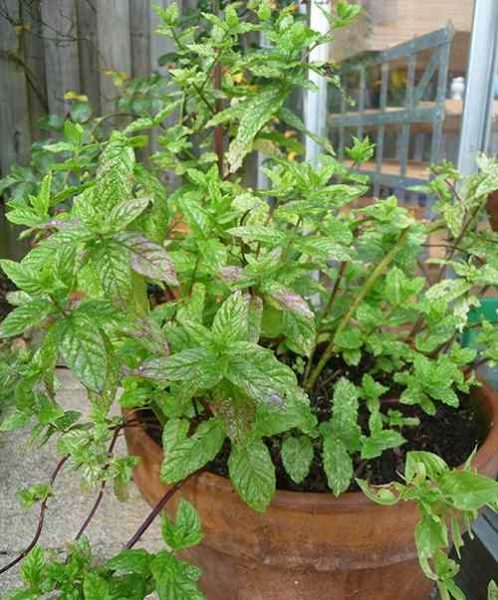 This sweet herb can be used as a base ingredient in common cold and flu remedies designed to treat coughs and respiratory problems. Peppermint can also be a vital ingredients in natural asthma, tuberculosis, allergy, and digestive issue home remedies.
This sweet herb can be used as a base ingredient in common cold and flu remedies designed to treat coughs and respiratory problems. Peppermint can also be a vital ingredients in natural asthma, tuberculosis, allergy, and digestive issue home remedies.
Peppermint Growing Tips
#1. Peppermint should be planted by a window that offer only light sun or partial shade.
#2. It grows best in a lightweight and moist potting soil.
#3. Place Light Full sun to part shade.
#4. Space started plants approximately 18 to 24 inches apart.
#5. Mature peppermint plants typically grow to hit one foot to three feet tall.
Related: Make Your Own Peppermint Oil – The Best Insect Repellent
Echinacea
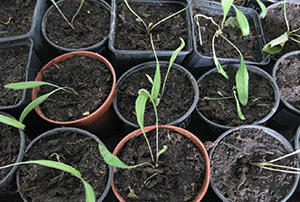 This beautiful plant can be brewed into a tea to help prevent and fight the common cold, flu, and related respiratory conditions. Adults often consume the tea in a standard coffee cup, up to our times daily as soon as they begin to feel ill. It may take a week to 10 days of the echinacea tea treatment to defeat a cold and cough symptoms.
This beautiful plant can be brewed into a tea to help prevent and fight the common cold, flu, and related respiratory conditions. Adults often consume the tea in a standard coffee cup, up to our times daily as soon as they begin to feel ill. It may take a week to 10 days of the echinacea tea treatment to defeat a cold and cough symptoms.
Echinacea has also been known to boost the immune system and help ward off infection, as well.
Echinacea Growing Tips
#1. These plants thrive on a small amount of water, yet the soil should not be allowed to dry out.
#2. Echinacea will grow best in nutrient rich soil and full sun.
#3. This medicinal plant can survive a light frost if you ever need to move them outside.
#4. They take about 90 to 120 days to grow from seed to flower and can hit 48 inches tall.
Thyme
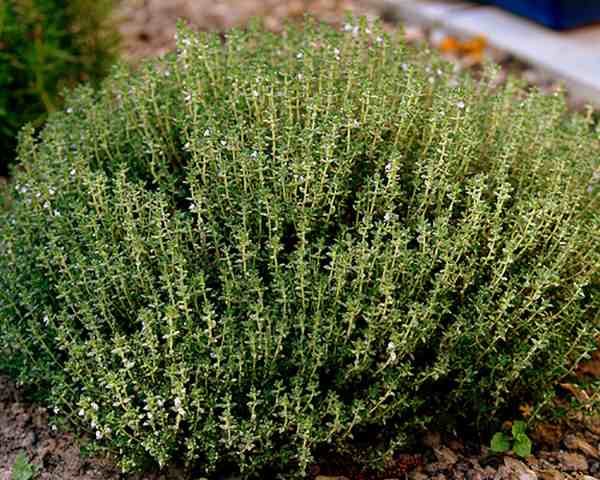 Thyme is one of the easiest to grow medicinal herbs and can be cultivated entirely indoors – even in a windowsill. This healing spice is believed to possess insecticidal, antiseptic, and antibacterial properties. Thyme was used to help protect people from “Black Death” in Europe during the 1300s.
Thyme is one of the easiest to grow medicinal herbs and can be cultivated entirely indoors – even in a windowsill. This healing spice is believed to possess insecticidal, antiseptic, and antibacterial properties. Thyme was used to help protect people from “Black Death” in Europe during the 1300s.
Brewed or steeped thyme may also help facilitate sleep and relieve stress. Drinking thyme tea can help curtail coughing fits and boost the immune system.
This medicinal herb is also comprises of thymol, a natural biocide compound. This compound can help destroy infectious bacteria and other types of destructive organisms. A 2010 study maintains thymol could reduce a bacterial resistance to many types of commonly prescribed medications, including penicillin.
Thyme Growing Tips
#1. Grow in full sun.
#2. Provide a steady supply of water, but avoid watering too much,
#3. Use a lightweight and well drained potting soil.
#4. Thyme grows best in a pH balance of 6.5 to 7.0.
I grow 36 types of medicinal herbs, plants, and roots inside our home and in our greenhouse. But, if I had only the space, time, and money to grow eight medicinal plants in order to treat the most several and common health issues that could arise during a SHTF event, these would without a doubt be the ones I would recommend most.
You may also like:
 23 Medicinal Plants the Native Americans Used on a Daily Basis
23 Medicinal Plants the Native Americans Used on a Daily Basis
This Homemade Device Can Power Up Your Entire House 7 Days In A Row (Video)
How To Make Antiseptic Sugardine To Treat Wounds And Inflammation















Where did you get the dwarf Moringa seeds. I just spent 30 minutes on-line and everybody wanted $20 or more.
I bought mine from Baker Creek. http://www.rareseeds.com
To red, Baker Creek has beautiful live young turmeric plants. My live plants from them have thrived, and their seeds are so fresh, I could smell each packet as I removed it.
There are countries where moringa root is eaten (though not recommended here) and compared to horseradish, so I figured I’d try it, but further research indicated the moringa root contains a potent neurotoxin, while the rest of the plant is beneficial. At some point I plan to find out what neurotoxin it contains, and if there is medicinal value if used with caution. Til then, the rest of the tree will be among my favorites.
Baker’s Creek is a good site. I recommend them, but also recommend a buyer be wary: there’s so much stuff it’s hard to NOT buy what you don’t need. Did you try the kajari melons? I’m not much for honeydew, but these were good. Just wait till the white strips turn yellow for the sweetest ones. Also got their Ancient watermelon, which is supposed to do well in Arizona.
I’m waiting for the moringia dwarfs to start growing. We’ve had a lot of cold nights lately, unusual for here, in May. I heard about the toxins, and the ground squirrels are welcome to it. That would be better than planting castor beans. niio
Got mine from JL Hudson Seedsman, in California. 3 or 4 bucks for ten seeds..
Does anyone know where I can buy organic ginger?
Thank you!
I get mine from Baker Creek Heirloom Seeds. This week they were out of stock, but will email you when they receive more, if you request. Johnny’s Select Seeds is also good, but I’m unsure if they carry moringa (I think they do.). Both companies strive to preserve rare seeds from all over the world, particularly organic and non-GMO. Great service, integrity, and products. Their free catalogs are fabulous, too.
You left out cannibus sativa. Good for treating pain, and anxiety. The long stalks make excellent rope. Kind of hard to grow indoors, unless you have some righteous grow lamps.
Grocery stores. If your local grocery store does not carry organic ginger, try a health food store/grocery like Mother’s or Wild Oats.
Just pot a piece from the grocery store in organic soil, don’t buy a plant which may have been sprayed. I grow then in my living room, same as turmeric.
Besides Baker Creek for Moringa and try a health food store ginger. I also use this source for sweet potatoes to plant.
a health food store or even Grocery Outlet sometimes carries it if you live near one or an oriental grocery…
Thanks so much for sharing
Don’t forget Aloe Vera! This is an amazing plant to heal burns, cuts and wounds.
I have more moringa anyone need contact me
Suryapkm96@gmail.com. organic also available for lowest price
Trees or seeds?
You left out cannibus sativa. Good for treating pain, and anxiety. The long stalks make excellent rope. Kind of hard to grow indoors, unless you have some righteous grow lamps.
I have grown Ginger & Horseradish from Grocery store roots.This might work for others.
Quite useful. Can’t wait to get my own. Am a fan of my own produce and to have it all at had is even more desirable.
If you want to grow the best kind of tarragon you need to start with a plant. French Tarragon is not available from seed.
We have Mexican tarragon. French tarragon burns up in the heat (Arizona). Thyme thrives here, as do a lot of other things. niio
A lot of my clients are from India. They work in the Tech sector here and all have much nicer homes than I could ever afford, but they treat their backyards like they were still living in a village back home growing moringa, turmeric, and ginger in the beds and in pots and making little greenhouses to overwinter plants in. I was at a half million dollar house in a golf course community and right there alongside the Fairway they had pots of Moringa and in the beds pigweed Amaranthus 5 feet high! Tulsi Gabbard must have subverted their HOA…
If youre able to afford a half million dollar house, I’m not sure caring about the HOA is all that high on your priority list.
On the Garlic planting tips #2, shouldn’t the pointy end go up as that is where the green shoots emerge? Think of a teardrop.
Point UP. I put the garlic to be planted in the refrigerator until I see new roots, always on the broad base before I plant them.
Echinacea can grow just about anywhere in the planet. I live in growing zone 3. It can go down to -35 F (-37.22) and sometimes even lower (like this year). I have them all over my front yard, they come back every year and once the seed head is dry, you can just sprinkle them where ever there is soil. Of course if you are going to dig the root in the middle of winter when the soil is frozen solid it helps to have a few in pots, otherwise that “light frost” is very inaccurate. By the way, Tarragon also can survive here, but they are not a long lasting plant (years but not decades, unlike Echinacea), so you should start others from your plant. As to starting from plant, as someone mentioned, very accurate, because the seeds sold as tarragon are NOT the real thing. They just look similar.
the first devil wind to come along eats the French tarragon (hot, dry, up to 40 mph). It doesn’t like our gracious weather. Even Mexican has to be protected from the wind. Of course, that’s true of about everything, even cactus 🙂 Thank you for the reminder! I need to buy eachancia seeds, and get them in by December. niio
It would be great to have these articles available in hard copy. Just the articles themselves without comments section. I don’t have a printer. these articles could be published in pamphlet form every quarter and would be very handy. If some event took place, such as EMP, I cant go to my computer and pull up items that I need but I could pick up and o through my notebooks . This is when we will need much of this information. Thanks, Virgil
Yo, I save them on a memory stick if I can’t find hard copy. When I get a book’s worth, then they get printed out on acid proof paper and sealed in plastic for future reference when we can’t open a computer. niio
Virgil, I hope this helps if the website admin doesn’t have hard copies available. I too, didn’t have a printer until recently (and still haven’t used it, nor do I have a computer), but there are simple, free word processing apps you can download for phones, and cheap printers for text, to use with smart phones, so you can print more info onto the size pages of your choice, according to what options you’ve chosen in your research of reviews. Ask knowledgeable personnel in stores as you shop.
I would agree. The price of printers today is ridiculously low. Personally, I can’t imagine not having a printer. I have a Canon printer that cost less than $60. It can do things that 30 years ago could only be done on a $100,000+ huge machine. It can copy very good quality color. It can enlarge and reduce in color as well as black. The print quality is truly amazing. And it is probably 5 years old now so it has in all likelihood been surpassed by another device that will have even more features. I buy ink cartridges from inkfarm.com and they work just fine in it at a significant discount from the big box office supply stores. It’s all manual, if I want to duplex copies, I have to turn them by hand and I have to place the originals by hand, no automatic feed but with the number of copies I make a month, it is not a problem. Having been in the printing business and having paid $3500.00 for a fax machine to offer the first commercial fax service in the county, the reduction in cost and the added capability is truly astounding.
Believe it or not, these plants can be grown outdoors also.
Thanks for the inkfarm.com link, left coast chuck, and the added insight. My last computer and printer were from the 90’s, so most of the advances are amazing to me as well.
Those looking for printers, Amazon has an HP printer (actually it prints, scans and copies) for $39.89. Hooking one up is simple…one cord goes to house power, the other plugs into USB on both sides. Your computer should automatically recognize it, though you might have to click an OK button once or twice. Canon or Epson might have them at that price or less, I didn’t check. Here’s the link: https://www.amazon.com/HP-DeskJet-2655-Compact-Replenishment/dp/B06XHXWB7B/ref=sr_1_2?keywords=hp+printer&qid=1557346790&refinements=p_89%3AHP&rnid=2528832011&s=gateway&sr=8-2
Cannot grow European tarragon here. It fries in the heat. Mexican tarragon thrives, though.
I’m going to try the dwarf moringa. I hear some are sensitive to the roots, but I want to see for myself. As most of the rodent population died mysteriously (and I’m hoping it’s not the plague, back) they should thrive outside.
Turmeric loves the same as its cousin, ginger. I can grow ginger, and turmeric is going to be planted in a pot in the house when I can get some. The ginger is outside and sulking because the weather turned cool, then scorching hot and now is cool, again.
Garlic! This year makes my third attempt to get Creole, which does best in the South. The other two times, I was sent some sort of striped crap that crapped out. Ajo Rojo is so strong, it’s used mostly as a medicinal. Cuban Creole is so mild people eat it like scallions. Creole garlic can be stored up to a year if hung in a paper bag in an airy, out of the sun place. No other garlic does that.
Peppermint, to the surprise of neighbors, is drought tolerant when established. It does best in a moist, even wet environment, but does well here, also, where we get only 13 inches of rain a year. Best use to smoked for lung problems, including asthma.
Thyme: It loves Arizona, even full sun, 100+ degree weather and no rain for months. Very drought tolerant. Good hidden garden as a ground cover. Every walk in the garden makes you hungry for roast chicken with stuffing 🙂 And, it tolerates being walked on.
You missed our fav righteous major herb, tobacco. Still has niio
You are forgetting the most important medicinal plants, Cannabis